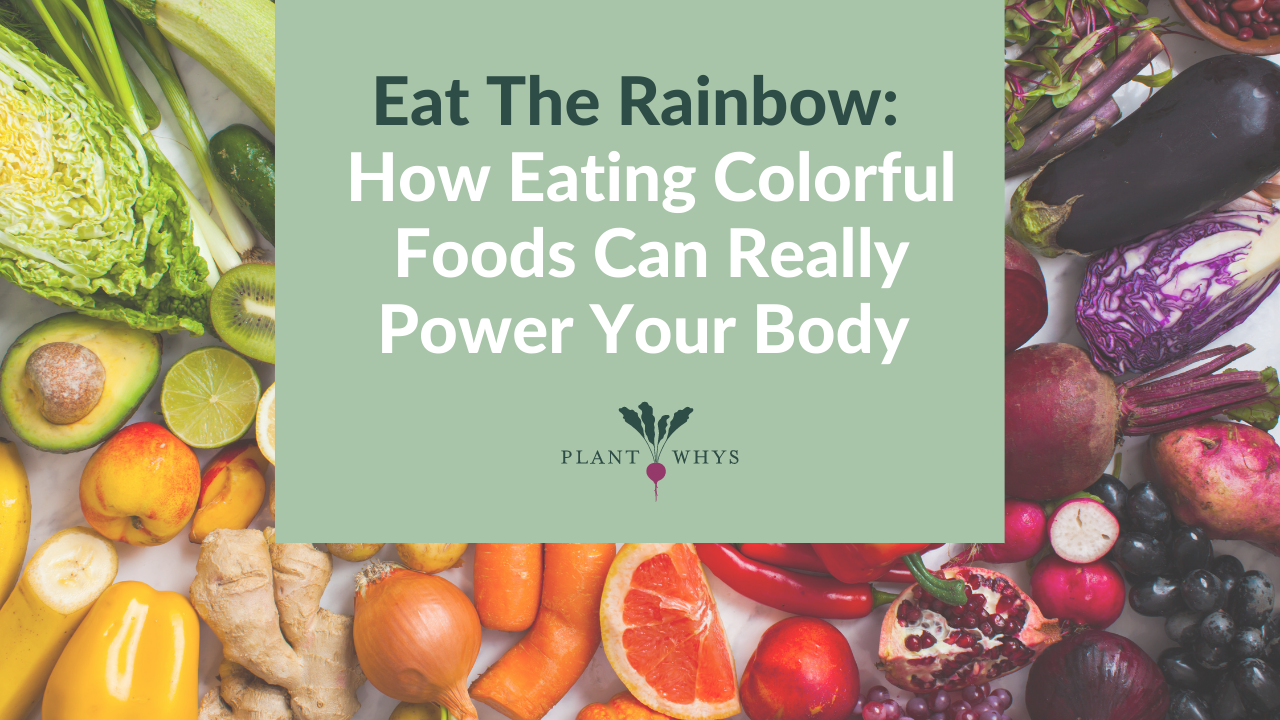Eat The Rainbow: How Eating Colorful Foods Can Really Power Your Body
May 29, 2022
Colorful Plant Foods Give You the Best Bang For Your Buck
With food prices fluctuating, we are all feeling it a bit in our wallets. You’re probably wondering what’s the best way to eat nutritiously on a budget? At PlantWhys, we can’t emphasize the power of plants when it comes to nutrient quality and cost. Let’s find out more about how plant foods are the best thing to eat in any market.
It’s a Win-Win! Eating A Variety of Colorful Plants Gives You A Variety of Nutrients
Plants contain different naturally-occurring pigments, or phytonutrients, which give them their color. Different-colored plants are linked to higher levels of specific nutrients and specific health benefits including antioxidant and anti-inflammatory activity. Focusing on eating a variety of colors will increase your variety of nutrients to benefit various areas of your health.
It Gives You More Plant Power to Fight Disease
Additionally, different vegetables may target different cancers. Radishes are completely unable to stop pancreatic cancer cell growth. However, radishes were 100 percent effective at halting the growth of stomach cancer cells. Orange bell peppers were useless against stomach cancer, but they were able to suppress prostate cancer cell growth by more than 75 percent. Eggplant, bok choy, carrot, tomato, endive, fennel, and romaine lettuce appeared useless at suppressing breast cancer cell growth. But cauliflower, brussels sprouts, green onion, leek, and garlic abolished cancer growth completely.
Different vegetables can even produce different results within the same organ. For example, cabbage, cauliflower, broccoli, and brussel sprouts are associated with lower risk of colon cancer in the middle and right side of your body, whereas risk of colon cancer farther down on the left side appears to be lowered more by carrots, pumpkins and apples. That is why a diversified diet containing several distinct classes of phytochemicals is essential for effectively reducing risk of cancer and other diseases.
Eating More Plants Is Really Good For Your Gut
Most Americans don’t eat enough fiber, so the good news is–when you eat more plants, you naturally eat more fiber-containing foods. Let’s just say that when your gut is happy from eating fiber, you are definitely going to be overall one happy camper as well. Plants can contain a specific type of phytochemical known as polyphenols, which are super good for your gut because it’s easily digested and absorbed by our gut bacteria and can emit some powerful effects such as killing off more harmful bacteria found in our bodies.
You Really Can’t Go Wrong with Eating More Colorful Plants
In summary, by getting a variety of color in your diet, you’re giving your body an array of vitamins, minerals, and phytochemicals to benefit your health. Here are the unique nutrients of each color.
Which colorful plants are you going to try this week?
-
Yellow: Rich in vitamin C which helps with circulation, detoxification and inflammation. Examples include yellow apples, bananas, grapefruit, corn and yellow squash and peppers.
-
Orange: Contains beta-carotene that helps to improve immune system function, eye health and may reduce the risk of heart disease. Examples include oranges, peaches, cantaloupe, sweet potatoes and carrots.
-
Purple: Anthocyanins, natural plant pigments that produce a rich purple color, help improve memory function and may reduce free radical damage to the body’s cells. Foods rich in these properties include blackberries, plums, prunes, blueberries, eggplant and red cabbage.
-
Red: A good source of the antioxidant lycopene that promotes protection of cells. Studies have shown it is beneficial to heart health. Red apples, strawberries, watermelon, tomatoes, beets and red potatoes are good sources.
-
Green: Rich in folate, these fruits and vegetables promote heart health and has been known to improve digestion. Examples are green apples, kiwi, green grapes, honeydew melon, broccoli, avocado, zucchini, celery, and leafy greens.
-
White: Containing allicin, white produce helps lower cholesterol and blood pressure and may reduce the risk of cancer. White peaches, pears, coconut, onions, mushrooms, cauliflower, and white corn are good sources.
References:
Greger, Michael. (2015). How Not To Die: Discover the Foods Scientifically Proven to Prevent and Reverse Disease.
Nielsen, Desiree. (2022). Good For Your Gut: A Plant-Based Digestive Health Guide and Nourishing Recipes for Living Well.
Chu YF, Sun J, Wu X, Liu RH. Antioxidant and antiproliferative activities of common vegetables. J Agric Food Chem. 2002 Nov 6;50(23):6910-6. doi: 10.1021/jf020665f. PMID: 12405796.
Wallace TC, Bailey RL, Blumberg JB, Burton-Freeman B, Chen CO, Crowe-White KM, Drewnowski A, Hooshmand S, Johnson E, Lewis R, Murray R, Shapses SA, Wang DD. Fruits, vegetables, and health: A comprehensive narrative, umbrella review of the science and recommendations for enhanced public policy to improve intake. Crit Rev Food Sci Nutr. 2020;60(13):2174-2211. doi: 10.1080/10408398.2019.1632258. Epub 2019 Jul 3. PMID: 31267783.
Mozos, I., Stoian, D., Caraba, A., Malainer, C., Horbańczuk, J. O., & Atanasov, A. G. (2018). Lycopene and Vascular Health. Frontiers in pharmacology, 9, 521. https://doi.org/10.3389/fphar.2018.00521
Tan, B. L., & Norhaizan, M. E. (2019). Carotenoids: How Effective Are They to Prevent Age-Related Diseases?. Molecules (Basel, Switzerland), 24(9), 1801. https://doi.org/10.3390/molecules24091801
Royston, K. J., & Tollefsbol, T. O. (2015). The Epigenetic Impact of Cruciferous Vegetables on Cancer Prevention. Current pharmacology reports, 1(1), 46–51. https://doi.org/10.1007/s40495-014-0003-9
Blesso C. N. (2019). Dietary Anthocyanins and Human Health. Nutrients, 11(9), 2107. https://doi.org/10.3390/nu11092107
Rahimi P, Abedimanesh S, Mesbah-Namin SA, Ostadrahimi A. Betalains, the nature-inspired pigments, in health and diseases. Crit Rev Food Sci Nutr. 2019;59(18):2949-2978. doi: 10.1080/10408398.2018.1479830. Epub 2018 Nov 18. PMID: 29846082.
Click here to learn more about our plant-based membership called, The Collective
Stay connected with news and updates!
Join our mailing list to receive the latest plant-based tips, tricks, and recipes.
Don't worry, your information will not be shared.
We hate SPAM. We will never sell your information, for any reason.

